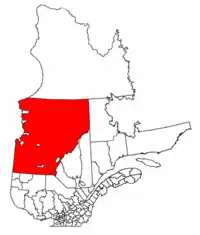Baie-James | |
|---|---|
 | |
| Motto: "A territory the size of a country" | |
 Municipality of Baie-James, Quebec | |
| Coordinates: 52°00′N 76°00′W / 52.000°N 76.000°W[1] | |
| Country | Canada |
| Province | Quebec |
| Region | Nord-du-Québec |
| RCM | None |
| Constituted | July 14, 1971 |
| Dissolved | July 24, 2012 |
| Government | |
| • Mayor | Gérald Lemoyne |
| • Federal riding | Abitibi—Baie-James—Nunavik—Eeyou and Abitibi—Témiscamingue |
| • Prov. riding | Ungava |
| Area | |
| • Total | 335,818.20 km2 (129,660.13 sq mi) |
| • Land | 297,332.84 km2 (114,800.85 sq mi) |
| Population (2011)[3] | |
| • Total | 1,303 |
| • Density | 0.0/km2 (0/sq mi) |
| • Pop (2006–11) | |
| • Dwellings | 701 |
| Time zone | UTC−05:00 (EST) |
| • Summer (DST) | UTC−04:00 (EDT) |
| Postal code(s) | |
| Area code | 819 |
| Website | www |
The Municipality of Baie-James (French: Municipalité de Baie-James) was a municipality in northern Quebec, Canada, which existed from 1971 to 2012. Located to the east of James Bay, Baie-James covered 297,332.84 km2 (114,800.85 sq mi) of land, making it the largest incorporated municipality in Canada — only eight unorganized territories were larger.[4] Its territory almost entirely (about 98%) covered the administrative region of Jamésie, although it contained less than five percent of the population. Essentially, it was the remainder of the Jamésie Territory's land after all of the major population centres were removed.
On July 24, 2012, the Quebec government signed an accord with the Cree that would result in the abolition of Baie-James and the creation of a regional government known as Eeyou Istchee James Bay Territory.[5]
The hydroelectric power plants of the La Grande Complex were all located within the municipal boundaries of Baie-James, making the municipality strategically important to Quebec's energy policy. Other important economic sectors are mining, softwood logging, forestry, and tourism.
History
The municipality was created in 1971 and was run by the board of directors of the Société de développement de la Baie James. It managed the territory of the James Bay and Northern Quebec Agreement between the 49th and 55th parallel, with the exception of the Cree Category 1 lands and the enclaves of Chapais, Chibougamau, Lebel-sur-Quévillon and Matagami.
In December 2001, the municipal council was reformed. It became a municipality of a special type directed by the mayors of the four enclave towns, as well as the chairpersons of the local community councils of Radisson, Valcanton and Villebois. An eighth seat is reserved for a representative coming from the non-urban territory. The municipality gained additional authority and can exert certain powers as a regional county.
Under the terms of the Agreement on Governance in the Eeyou Istchee James Bay Territory of July 24, 2012, the municipality ceased to exist and was replaced by a new regional government called Eeyou Istchee James Bay Territory.[6]
Communities in Baie-James
- Beaucanton
- Desmaraisville
- Joutel
- Miquelon
- Radisson - northernmost non-native town in Quebec.
- Val-Paradis
- Valcanton
- Villebois
Demographics
| 2011 | |
|---|---|
| Population | 1,303 (-6.5% from 2006) |
| Land area | 297,332.84 km2 (114,800.85 sq mi) |
| Population density | 0.0/km2 (0/sq mi) |
| Median age | 44.8 (M: 45.6, F: 43.4) |
| Private dwellings | 701 (total) |
| Median household income | $61,770 |
Transportation

The primary roads to and within Baie-James are:
- Route 109 - provincial highway to Matagami
- Route 113 - provincial highway from Val-d'Or to Chibougamau
- Route 393 - regional highway to Val-Paradis
- James Bay Road - road from Matagami to Radisson
- North Road
- Trans-Taiga Road - access road to hydro-electric stations of the James Bay Project
Air transportation is through the La Grande Rivière Airport near Radisson, which provides scheduled air service to Montreal and Puvirnituq.
Geography
Nearby lakes include Lake Naococane.
References
- ↑ "Banque de noms de lieux du Québec: Reference number 3072". toponymie.gouv.qc.ca (in French). Commission de toponymie du Québec.
- 1 2 "Ministère des Affaires municipales, des Régions et de l'Occupation du territoire: Baie-James". Archived from the original on 2016-03-05. Retrieved 2012-03-11.
- 1 2 "Baie-James census profile". 2011 Census of Population. Statistics Canada. 8 February 2012. Retrieved 2012-02-09.
- ↑ Population and dwelling counts, for Canada, provinces and territories, and census subdivisions (municipalities), 2006 and 2001 censuses
- ↑ Lia Lévesque (24 July 2012). "Québec et les Cris signent une entente pour un gouvernement régional". La Presse. La Presse Canadienne. Retrieved 2012-07-24.
- ↑ "The Grand Council of the Crees (Eeyou Istchee) > Signing of an agreement between the Government of Québec and the Cree Nation". Archived from the original on 2014-11-13. Retrieved 2012-07-24.
- 1 2 "Electronic Area Profiles". Canada 1996 Census. Statistics Canada. Retrieved 2014-01-28.
- ↑ "2011 Community Profiles". 2011 Canadian Census. Statistics Canada. March 21, 2019. Retrieved 2014-01-28.
- ↑ "2006 Community Profiles". 2006 Canadian Census. Statistics Canada. August 20, 2019.
- ↑ "2001 Community Profiles". 2001 Canadian Census. Statistics Canada. July 18, 2021.
External links
- Website of the Eeyou Istchee James Bay Regional Government Archived 2015-06-27 at the Wayback Machine
- Grand Council of the Crees
- Cree Tourism
- Municipality of Baie-James
- Human Environment of the James Bay region (Detailed map of the James Bay region)
- Map of Baie-James